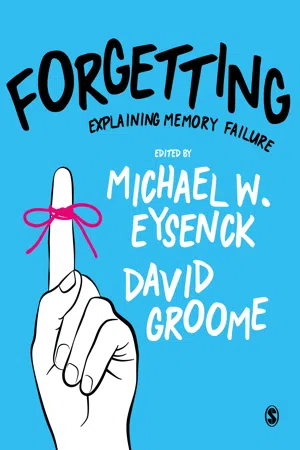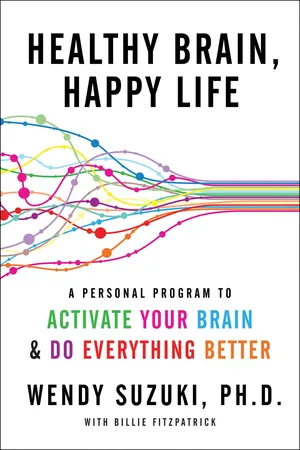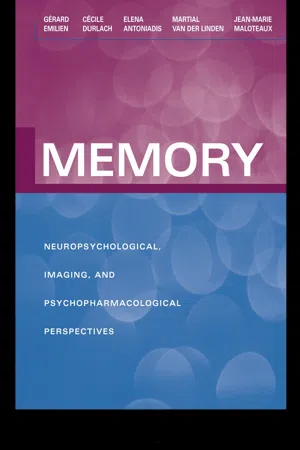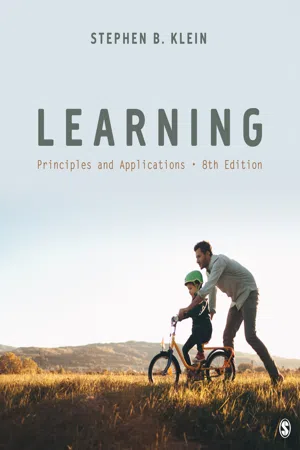Psychology
Patient HM
Patient HM, whose real name was Henry Molaison, was a famous case study in psychology. He underwent brain surgery to treat severe epilepsy, which resulted in profound amnesia. His case provided valuable insights into the role of the hippocampus in memory formation and led to significant advancements in our understanding of memory and amnesia.
Written by Perlego with AI-assistance
Related key terms
5 Key excerpts on "Patient HM"
- eBook - ePub
Forgetting
Explaining Memory Failure
- Michael W. Eysenck, David Groome, Michael W. Eysenck, David Groome(Authors)
- 2020(Publication Date)
- SAGE Publications Ltd(Publisher)
While the surgery was considered a success in terms of managing the seizure disorder, an unexpected consequence was a severe and irreversible memory loss characterised by severe and global anterograde memory impairment (i.e. profoundly disrupted ability to form new memories) and a temporally graded retrograde amnesia (i.e. loss of previously acquired memory, with greater deficit in the time period close to the surgery and better memory moving back in time). The subsequent neuropsychological and neuroanatomical descriptions of HM have provided significant insight into the organisation of human memory and its instantiation in the brain (see also Corkin et al., 1997; Corkin, 2002). From HM, and from other cases of amnesia, we have learned that damage to the hippocampus and related medial temporal lobe regions, whether by surgical resection, as in HM, or following anoxia or other neurological insult, results in a profound yet circumscribed amnesia. The specificity of the observed impairment in HM was of critical importance. The impairment was specific to the domain of memory, as well as specific within the domain of memory. The impairments are seen in aspects of memory function, disproportionate to any deficits in general cognitive or intellectual abilities. HM had not lost the capacity for speech and language (i.e. he did not have aphasia) and his other cognitive abilities were intact including attention, problem solving, and reasoning. Moreover, the observed impairment in HM affected only certain aspects, or forms of memory - eBook - ePub
Healthy Brain, Happy Life
A Personal Program to to Activate Your Brain and Do Everything Better
- Wendy Suzuki, Billie Fitzpatrick(Authors)
- 2015(Publication Date)
- Dey Street Books(Publisher)
is one of the most fascinating and most extensively studied neurological patients in the learning and memory literature. After Brenda Milner’s work with him, her then graduate student and now professor emerita at MIT Suzanne Corkin studied H.M. for a total of forty-seven years, until his death in 2008. If you want to know more about patient H.M. and his story, I recommend Corkin’s wonderful book, Permanent Present Tense: The Unforgettable Life of the Amnesic Patient H.M. Listen to me interview Suzanne about H.M. on the podcast Transistor by PRX. But this was not all Milner noticed. Once she characterized the severity of H.M.’s everyday memory loss, she got to work figuring out if there was anything at all he could learn and remember normally. She and others later showed that H.M. had an inability to form any new memories for facts (termed semantic memory) or events (termed episodic memory), typically referred to together as declarative memory—the kind of memory that can be consciously brought to mind. Next Milner revealed that H.M. did have normal memory for some things. Namely, she showed that he still had the ability to learn new motor or perceptual skills at the same rate as people who had not undergone surgery. Milner had him do tests in which he had to learn how to trace a figure accurately while looking in a mirror. H.M. improved steadily day by day but, strikingly, had no memory of ever having done the task before. Similarly, he was able to learn perceptual tasks in which he was given a vague outline of a picture and, after a variable amount of time looking at the incomplete figure, gradually picked out the image. He learned to identify those objects at the same rate as nonpatients as well. This was another revelation in the memory field - eBook - ePub
Memory
Neuropsychological, Imaging and Psychopharmacological Perspectives
- Gérard Emilien, Cécile Durlach, Elena Antoniadis, Martial Van der Linden, Jean-Marie Maloteaux(Authors)
- 2004(Publication Date)
- Routledge(Publisher)
Studies on the role of the medial temporal lobe in the memory system suggest that this part of the brain performs a critical function beginning at the time of learning to establish a long-term declarative memory (Mishkin, 1982; Squire, 1987). Its role continues after learning for a lengthy period of reorganisation and consolidation whereby memories stored in neocortex eventually become independent of the medial temporal lobe memory system. This process, by which the burden of long-term permanent memory storage is gradually assumed by the neocortex, ensures that the medial temporal lobe system is always available for the acquisition of new information. Such a hypothesis suggests that lesions of the medial temporal lobe interfere only with the long-term storage of new memories. Patients like HM, who due to the severity of his epilepsy had the medial temporal lobes of his brain removed to prevent almost constant seizures, retain a reasonably good memory of earlier events (Milner, 1985; Scoville & Milner, 1957; Squire, 1987). He showed deficiency in declarative memory—he cannot recollect new events in his life or new facts about the world but is able to learn new visuomotor skills (e.g., reading in a mirror after several practice sessions) without awareness of having been previously tested. Patient HM’s case triggered several important hypotheses that have significantly impacted the study of the neuroanatomical basis of memory. HM’s deficits were initially attributed to his hippocampal damage (resulting from his bilateral medial temporal lobectomy). This was the first case implicating the hippocampus in memory. The view that mnemonic functions are diffusely represented throughout the forebrain was challenged. The findings from HM triggered many studies to investigate the role of the hippocampus in learning and memory in both animals and men. They provided the first evidence that implicit memory could survive in the absence of explicit memory. The implication of the medial temporal lobes in memory consolidation was suggested.The first lesions in most cases of AD may occur in the medial temporal lobe and this may account for amnesia being the most common initial problem in AD (Hyman et al., 1984). Unlike patients with pure amnesia, AD patients have a dementia defined by the compromise of at least one additional, non-mnemonic function. Further, AD patients also have early damage to cholinergic neurons in the basal forebrain and lesions in that area cause declarative memory impairments (Arendt et al., 1983). Therefore, it is not appropriate to ascribe the amnesia in AD exclusively to medial temporal injuries.Postmortem analysis of medial temporal damage in patients with well-characterised amnesias shows that damage restricted to a small part of the hippocampal region, the CA1 field, is sufficient to produce clinically significant anterograde amnesia. More extensive damage to additional medial temporal structures aggravates the severity of the anterograde amnesia and the temporal extent of the retrograde amnesia. When lesions extend beyond the hippocampal region into the entorrhinal and perirhinal cortices, retrograde amnesia extends back one or two decades (Corkin et al., 1997; Rempel-Clower et al., 1996). - eBook - ePub
Learning
Principles and Applications
- Stephen B. Klein(Author)
- 2018(Publication Date)
- SAGE Publications, Inc(Publisher)
In 1953, patient Henry Gustav Molaison (1926–2008), better known as H. M., had his medial temporal lobe (including the hippocampus, amygdala, and surrounding cortical tissue) removed as a treatment for epilepsy. Although the operation successfully treated his severe epilepsy, this success proved costly. While H. M. remained pleasant and good-humored after the operation, he suffered from a severe memory deficit. H. M. was very cooperative, and many researchers (Gabrieli, Cohen, & Corkin, 1988; Milner, 1970; O’Kane, Kensinger, & Corkin, 2004; Scoville & Milner, 1957) have examined the details of his memory disorder.The most profound deficit was H. M’s anterograde amnesia, or the inability to recall events that have occurred since the operation. For example, on each visit to the hospital, H. M. had to be reintroduced to his doctors. His inability to recall events that occurred following his surgery resulted from his failure to permanently store those experiences. H. M. also showed retrograde amnesia for events that took place only a few years prior to his operation. He can recall memories more than several years old, though, and he could carry on a conversation about those events. H. M. was fully aware of the extent of his memory impairment:Every day is alone in itself, whatever enjoyment I’ve had, and whatever sorrow I’ve had. . . . Right now, I’m wondering. Have I done or said anything amiss? You see, at this moment everything looks clear to me, but what happened just before? That’s what worries me. It’s like waking from a dream; I just don’t remember. (as cited in Milner, 1970, p. 37)While H. M. suffered severe memory impairment, some areas of his memory did remain intact. Squire (1987) suggested that although H. M. could not store episodic memories, he could store and recall procedural memories. Brenda Milner’s (1965) research clearly showed that H. M. could acquire new skills (procedural memories). In one study, H. M. participated in a mirror-drawing task (see Figure 12.17a). The task involves tracing an object while looking at it in a mirror. This task is difficult and requires practice. On this task, H. M.’s performance improved over a series of trials; he made fewer errors as he learned the task (see Figure 12.17b - eBook - ePub
Pieces of Light
The new science of memory
- Charles Fernyhough(Author)
- 2012(Publication Date)
- Profile Books(Publisher)
Claire understands the extent of the neurological damage behind these problems. At the age of forty-three, a common virus known as herpes simplex attacked her brain on both sides, causing most of its damage in the right hemisphere. Brain scans showed extensive lesions to the memory circuits of her right medial temporal lobe, with some frontal damage as well. As well as wiping out her memory, the virus also destroyed her senses of smell and taste. Claire’s understanding of her own condition is quite sophisticated. She knows that she doesn’t remember. She also knows that her problems are limited to episodic memory. Her semantic and procedural memories are fine: she knows the names of her four children, and the capitals of Europe, and she is perfectly capable of remembering how to operate her computer or bake her own bread. In this respect she has much in common with the most famous amnesic patient in history, Henry Molaison, who died in 2008 after fifty-five years of being unable to create new memories. Molaison had undergone an experimental procedure to treat chronic seizures, which had left his hippocampi seriously damaged on both sides. For reasons of patient confidentiality, for most of his life he was known to the world by the initials HM. Like Claire, HM was unable to recognise family members and scientists with whom he had worked for decades. In a 2007 interview, one of the neuropsychologists who studied him, Suzanne Corkin, observed: ‘He is in my PhD thesis and I have followed his progress for the last 43 years. And he still doesn’t know who I am.’The most convincing demonstration that HM had a specific problem with episodic memory came when his neuropsychologist, Brenda Milner, asked him to draw a complex pattern in a mirror. Copying a drawing without seeing your own hand, only your hand’s reflection, takes some tricky adjustments to your usual perception–action linkages (as you will know if you have ever tried to trim nasal hairs in a bathroom mirror). HM eventually mastered this difficult copying task, even though he could not recall individual occasions on which he had been trained in it. Like Claire, his procedural memory was intact – he could still help out in the garden or fix himself some lunch – but he could not lay down new episodic memories.I am wearing the READ HENRY MILLER badge because Claire also has a particular problem with recognising faces. Damage to her fusiform gyrus, towards the back and bottom of the temporal lobe, has left her with a condition known as prosopagnosia, or face blindness. She can literally see my face, of course, but she will not remember it. In the first days of her illness, the inability to recognise people who should have been fully familiar to her was incredibly distressing. Thinking about that confusion now still upsets her; she remembers the feelings if not the details of the events, in particular her frustration that she could not function in the way she used to: as a mother, wife or as a professional nurse. She had lost all feeling of connection to the people who mattered to her. ‘When you meet an old friend,’ she tells me, ‘you want to ask them about their lives, about their children. I couldn’t do any of that. They weren’t getting what they wanted from me. I wasn’t giving them back what they needed.’
Index pages curate the most relevant extracts from our library of academic textbooks. They’ve been created using an in-house natural language model (NLM), each adding context and meaning to key research topics.




